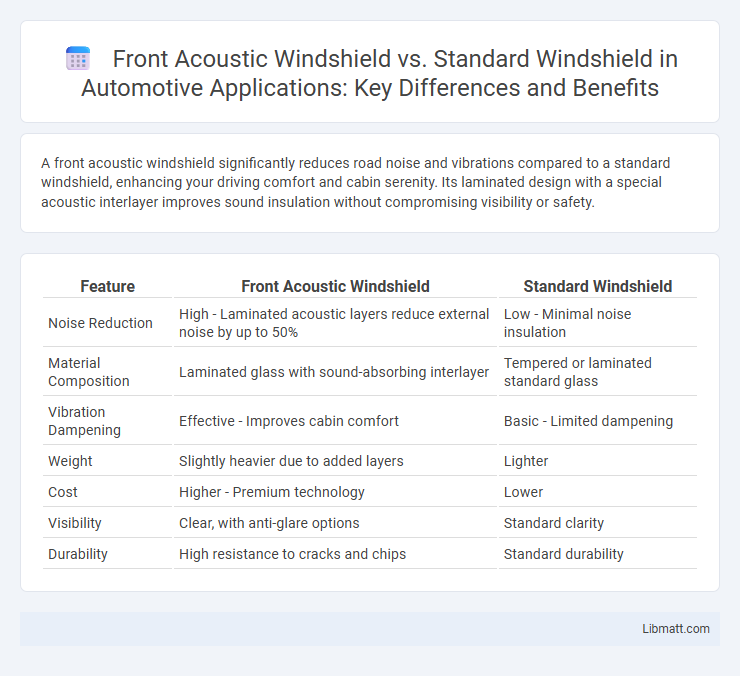A front acoustic windshield significantly reduces road noise and vibrations compared to a standard windshield, enhancing your driving comfort and cabin serenity. Its laminated design with a special acoustic interlayer improves sound insulation without compromising visibility or safety.
Table of Comparison
| Feature | Front Acoustic Windshield | Standard Windshield |
|---|---|---|
| Noise Reduction | High - Laminated acoustic layers reduce external noise by up to 50% | Low - Minimal noise insulation |
| Material Composition | Laminated glass with sound-absorbing interlayer | Tempered or laminated standard glass |
| Vibration Dampening | Effective - Improves cabin comfort | Basic - Limited dampening |
| Weight | Slightly heavier due to added layers | Lighter |
| Cost | Higher - Premium technology | Lower |
| Visibility | Clear, with anti-glare options | Standard clarity |
| Durability | High resistance to cracks and chips | Standard durability |
Introduction to Windshield Technologies
Front acoustic windshields utilize laminated glass with an inner acoustic interlayer designed to reduce noise transmission, enhancing cabin comfort compared to standard windshields. Standard windshields typically consist of two layers of glass with a polyvinyl butyral (PVB) interlayer focused primarily on safety and structural integrity rather than sound insulation. The integration of acoustic interlayers in front windshields marks an advancement in automotive glass technology, optimizing noise reduction without compromising visibility or durability.
What Is a Front Acoustic Windshield?
A Front Acoustic Windshield is engineered with specialized sound-insulating layers that significantly reduce external noise inside the vehicle cabin. Unlike a Standard Windshield, which primarily focuses on clarity and protection, this acoustic variant integrates laminated glass with a dedicated acoustic interlayer to dampen sound vibrations. This innovation enhances driving comfort by minimizing road, wind, and engine noise, providing a quieter and more serene environment.
Standard Windshield: Features and Composition
Standard windshields are typically made from laminated safety glass consisting of two layers of glass with a polyvinyl butyral (PVB) interlayer that enhances impact resistance and prevents shattering. These windshields provide essential protection against wind, debris, and UV rays while maintaining optical clarity for safe driving. Your vehicle benefits from the durability and cost-effectiveness of standard windshields, making them a reliable choice for everyday use.
Key Differences Between Acoustic and Standard Windshields
Acoustic windshields feature a multi-layer laminated design with a specialized sound-dampening interlayer, significantly reducing road noise and vibrations compared to standard windshields made of a single Plexiglas layer. The advanced acoustic laminate helps improve cabin comfort by filtering out external noise, making it ideal for luxury cars and long drives. Standard windshields, while durable and clear, lack the enhanced noise insulation properties, resulting in higher ambient sound levels inside the vehicle.
Noise Reduction Capabilities Compared
Front acoustic windshields significantly outperform standard windshields in noise reduction capabilities due to their multilayer laminated design, which effectively dampens road, engine, and wind noise. The acoustic interlayer in these windshields absorbs sound vibrations, resulting in a quieter cabin environment that enhances driving comfort. Compared to standard windshields, front acoustic windshields reduce noise levels by up to 10 decibels, making them a preferred choice for luxury vehicles and noise-sensitive drivers.
Safety and Structural Integrity
Front acoustic windshields enhance safety by incorporating laminated glass with a specialized acoustic interlayer that improves impact resistance and reduces noise intrusion. This structure increases the windshield's ability to withstand debris and collisions, maintaining the vehicle's structural integrity more effectively than standard windshields. Standard windshields, typically composed of two glass layers with a PVB interlayer, offer basic protection but lack the advanced sound-damping and reinforced durability features of acoustic variants.
Impact on Vehicle Comfort and Driving Experience
Front acoustic windshields significantly reduce external noise levels, enhancing in-cabin comfort and enabling clearer conversations or audio entertainment during driving. This sound insulation contributes to reduced driver fatigue and increased focus on the road, improving overall driving safety and experience. Standard windshields lack this advanced noise-dampening layer, resulting in higher wind and road noise infiltration that can disrupt comfort and concentration.
Cost Considerations: Acoustic vs. Standard Windshields
Front acoustic windshields typically cost 20-30% more than standard windshields due to their laminated multiple layers that reduce road and engine noise. Insurance premiums may be higher initially, but the improved insulation can lead to longer-term value by increasing cabin comfort and reducing driver fatigue. Replacement costs for acoustic windshields are also higher, reflecting advanced manufacturing technology and materials compared to conventional single-layer standard windshields.
Maintenance and Durability Factors
Front acoustic windshields feature laminated glass with a sound-dampening layer that not only reduces road noise but also enhances resistance to chips and cracks, increasing overall durability compared to standard windshields. Maintenance for acoustic windshields requires careful cleaning with non-abrasive materials to preserve the soundproofing layer, while standard windshields generally demand less specialized care. Your choice impacts long-term upkeep costs and windshield longevity, with acoustic windshields offering superior performance in noisy or high-impact environments.
Which Windshield Is Right for Your Vehicle?
Front acoustic windshields provide superior noise reduction by incorporating a special acoustic interlayer that minimizes external sound, enhancing cabin comfort compared to standard windshields. Standard windshields, made of conventional laminated glass, offer reliable protection and clarity but lack the advanced sound-dampening properties found in acoustic versions. Your choice depends on whether you prioritize a quieter driving experience or prefer a cost-effective option without the added noise insulation benefits.
Front acoustic windshield vs Standard windshield Infographic

 libmatt.com
libmatt.com